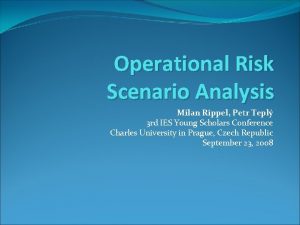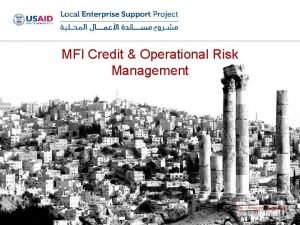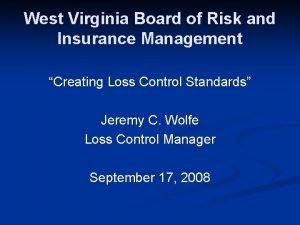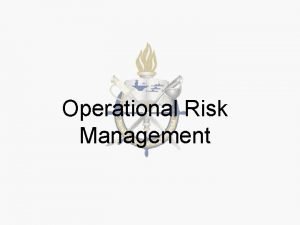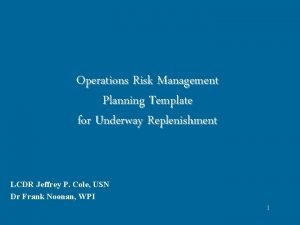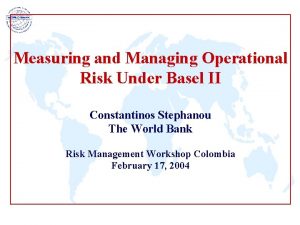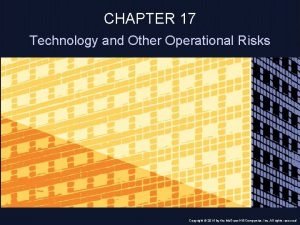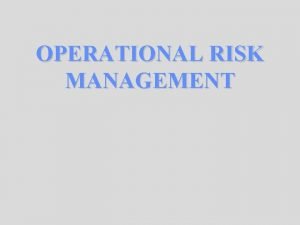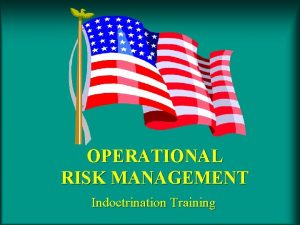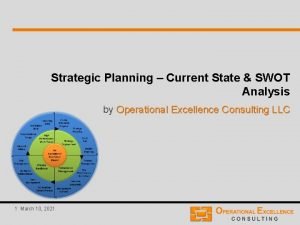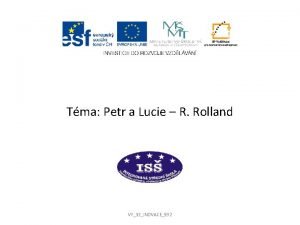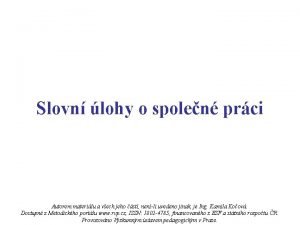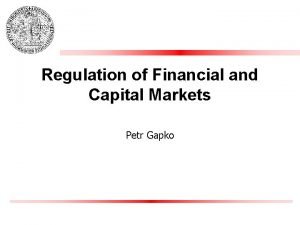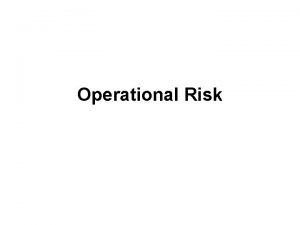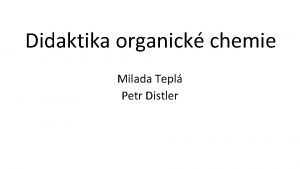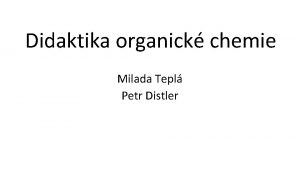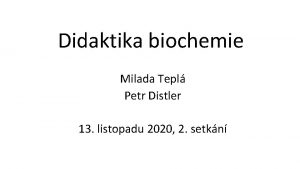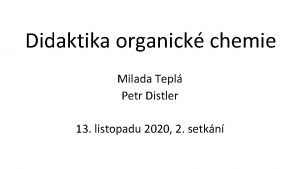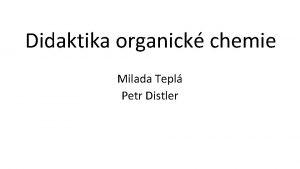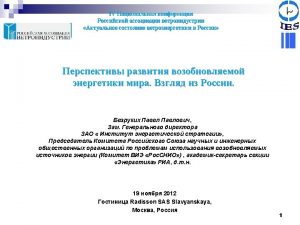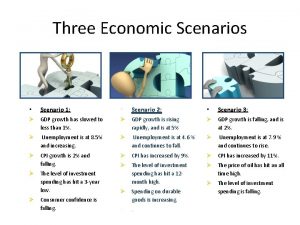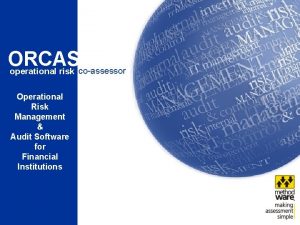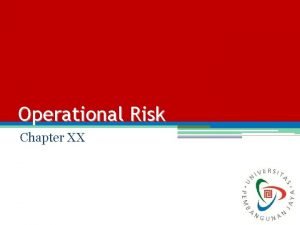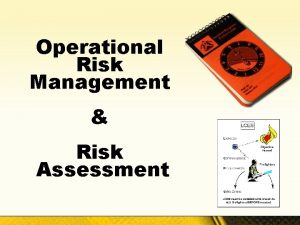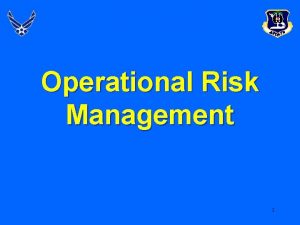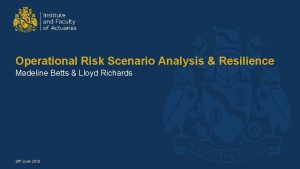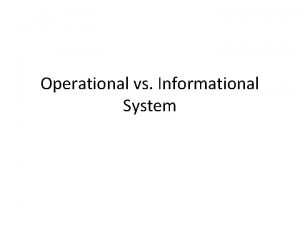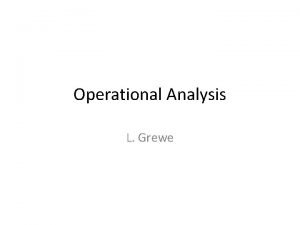Operational Risk Scenario Analysis Milan Rippel Petr Tepl






































- Slides: 38

Operational Risk Scenario Analysis Milan Rippel, Petr Teplý 3 rd IES Young Scholars Conference Charles University in Prague, Czech Republic September 23, 2008

Content 1. 2. 3. 4. 5. 6. 7. 11. 3. 2021 Introduction Operational risk & Basel II Operational risk measurement methodology Empirical data sample analysis Stress testing and scenario analysis Applied scenario analysis Conclusion Milan Rippel, Petr Teplý 2

Introduction (1/2) �This paper focuses on two main questions �What is the most appropriate statistical method to measure and model operational loss data distribution? �What is the impact of hypothetical plausible events on the financial institution? �Firstly, the risk measurement statistical techniques are evaluated and the most suitable ones used further for scenario analysis method in order to test whether those methods provide consistent results even if original data sample is enriched by adding a few extreme losses. �The best method for capital estimate computation is then chosen and effects of scenarios to the financial institution are assessed. 11. 3. 2021 Milan Rippel, Petr Teplý 3

Introduction (2/2) � Several statistical distributions are used to model loss severity distribution and compute capital estimates. � The best results are provided by a distribution that can reasonable model body as well as the heavy right tail of the data sample. � On the other hand, techniques that focus just on the tail of the distribution might not provide consistent results if the tail is contaminated by loss events defined during scenario analysis. � The distribution that is expected to be the most suitable for modeling the operational risk data is the g&h distribution used by Dutta, Perry (2007). The test hypotheses can be stated as: � H 0: The g&h distribution provides consistent capital estimates for scenario analysis method � H 1: Extreme Value Theory (EVT) provides consistent capital estimates for scenario analysis method. � Once this hypothesis is assessed the effects of extreme events on the financial institution can be evaluated. 11. 3. 2021 Milan Rippel, Petr Teplý 4

Literature overview �First rigorous studies on OR management were provided already in late 1990 s, e. g. works from Prof. Embrechts such as Embrechts et al. (1997), Embrechts et al. (2003) or Embrechts et al. (2006). �Given the scarcity and confidentiality of OR loss data, there are only few papers that explores specifics of OR data and are able to measure OR exposure with the accuracy and precision comparable with other sources of risk, however. �The most comprehensive studies are de Fountnouvelle (2006), Degen (2006), Embrechts (2006), Mignolla, Ugoccioni (2006), Chernobai (2007) and Dutta, Perry (2007). A scenario analysis method, a method used in this paper, is just very briefly mentioned in papers from Cihak (2004), Arai (2006) or Rosengren (2006). �For a detailed overview of the OR literature see Chalupka, Teply (2008) or Chernobai (2007). 11. 3. 2021 Milan Rippel, Petr Teplý 5

Content 1. 2. 3. 4. 5. 6. 7. 11. 3. 2021 Introduction Operational risk & Basel II Operational risk measurement methodology Empirical data sample analysis Stress testing and scenario analysis Applied scenario analysis Conclusion Milan Rippel, Petr Teplý 6

Operational risk - definition � Operational risk (OR) is the risk of loss resulting from inadequate or failed internal processes, people and systems or from external events. This definition includes legal risk, but excludes strategic and reputational risk. � Operational risk is a hot topic for both practitioners and researchers � The measurement and management techniques are under development � There is a lack of publicly available historical loss data � OR management is being required by Basel II � Operational risk event types: People Processes • Fraud, collusion and other criminal activities • Violation of internal or external rules • Management errors • Loss of important employees • Security violations 11. 3. 2021 Systems • IT problems • Unauthorized access • Unavailability of data • Communication failures • Utility outages Milan Rippel, Petr Teplý • Execution, registration, settlement errors (transaction risk) • Model and methodology errors (model risk) • Accounting errors • Compliance issues External Events • Criminal activities • Political and military events • Supplier failures 7

Operational risk events - examples �The most publicly known examples of OR would be those caused by fraud, natural disaster or unauthorized trading. �Examples of OR events: �the theft of USD 31 million in the G 4 S Cash Services from late 2007 �the failure of internet banking of Ceska Sporitelna in 12/2007 �the failure of computer systems in CSOB on 3 rd September 2008 �the large loss in the amount of USD 7. 5 billion caused to Société Générale by unauthorized derivatives trading by Jerome Kerviel. 11. 3. 2021 Milan Rippel, Petr Teplý 8

Operational risk – tail events 11. 3. 2021 Milan Rippel, Petr Teplý 9

OR Data �OR data suggest that there exists two kinds of events – the first category consists the losses of high frequency/low severity that are relatively unimportant for a bank and can often be prevented using risk mitigation techniques and covered by provisions. The second category consists of the low frequency/high severity events that are more important for a bank. � “Banks must be particularly attentive to these losses as these cause the greatest financial consequences to the institutions. ” Chernobai (2007) � If we consider statistical distribution of OR loss severity data the “existing empirical evidence suggest that the general pattern of operational loss data is characterized by high kurtosis, severe rightskewness and a very heavy right tail created by several outlying events. ” Distributions fitting such data are called leptokurtic. Chernobai (2007) 11. 3. 2021 Milan Rippel, Petr Teplý 10

Regulatory vs. Economic Capital �For OR modeling it is crucial to distinguish between regulatory and economic capital: �Regulatory capital is the amount of capital necessary to provide adequate coverage of banks’ exposures to financial risks as defined in the capital adequacy rules set by the Basel II. “A one-year minimum regulatory capital is calculated as 8% of risk-weighted assets. ” Empirical studies show that operational risk regulatory capital, in general, constitutes 10%-25% of overall capital adequacy requirements. �Economic capital “is a buffer against future, unexpected losses brought about by credit, market, and operational risks inherent in the business of lending money” or alternatively economic capital might be defined as the amount necessary to be in the financial business. 11. 3. 2021 Milan Rippel, Petr Teplý 11

Regulatory vs. Economic Capital 11. 3. 2021 Milan Rippel, Petr Teplý 12

Operational Risk & Basel II � Basel II sets three operational measurement methodologies for calculating operational risk capital charge “in a continuum of increasing sophistication and risk sensitivity”. � The first two approaches – Basic Indicator Approach (BIA) and Standardized Approach (SA) - are top-down approaches, because the capital charge is allocated according to a fixed proportion of gross income. � The third approach – Advanced Measurement Approach (AMA) - is a bottom-up approach, because the capital charge is estimated based on actual internal OR loss data. � � 11. 3. 2021 “Under the AMA, the regulatory capital requirement will equal the risk measure generated by the bank’s internal operational risk measurement system using the quantitative and qualitative criteria” that are given in Basel II BCBS (2006) The AMA thus provides significant flexibility to banks – on the other hand, regulators are given better control than the AMA techniques used by a particular financial institution. This paper focuses on Loss Distribution Approach (LDA), where regulatory capital charge is being estimated based on statistical models that work with historical OR data Milan Rippel, Petr Teplý 13

Content 1. 2. 3. 4. 5. 6. 7. 11. 3. 2021 Introduction Operational risk & Basel II Operational risk measurement methodology Empirical data sample analysis Stress testing and scenario analysis Applied scenario analysis Conclusion Milan Rippel, Petr Teplý 14

Models for OR measurement �Actuarial models for OR measurement have two key components that model historical OR loss data sample: 1. frequency 2. loss severity distributions �The capital charge is then computed as the value of Va. R 0. 99 measure of the one-year aggregate distribution loss. �Poisson distribution is being used to model OR loss frequency 11. 3. 2021 Milan Rippel, Pert Teplý 15

Loss severity distributions �Parametric distributions �g&h distribution �weibull distribution �lognormal distribution �gamma distribution �Extreme value theory (EVT) – different distribution for modeling tail and body of a data sample �block maxima method (BMM) � maximum observations over some period � BMM – Month �peak over threshold method (POTM) � the observation with loss higher than a set threshold � POTM – max 5% method 11. 3. 2021 Milan Rippel, Petr Teplý 16

Goodness of fit tests � GOFTs are divided into two classes – visual tests and formal tests. � The most commonly used visual test is Quantile-Quantile (QQ) plot which plots empirical data sample quantiles against the quantiles of the distribution that is being tested for fit. If such a distribution fits the data well then the QQ-plot would follow a 45 -degree line. � Formal GOFTs test whether the data sample follows a hypothesized distribution. The null and the alternative hypothesis are stated as: H 0 : The data sample follows the specified distribution H 1 : The data sample does not follow the specified distribution � Because of the OR the data specifics, the tests that are based on empirical distribution function are adequate measures for testing the GOF of particular distribution for OR loss severity modeling. � The tests belonging to this group are the Kolmogorov-Smirnov test (KS) and the Anderson-Darling (AD) test. All of them state the same hypothesis but uses different test statistics. 11. 3. 2021 Milan Rippel, Petr Teplý 17

Aggregate loss distribution Monte Carlo simulation with 50, 000 trials was used The algorithm is as follows: 1. Simulate a large number of Poisson random variates and obtain a sequence n 1, n 2, … n. MC representing scenarios of the total number of loss events in a one -year period. 2. For each of such scenarios nk simulate nk number of loss amounts using a specified loss severity distribution 3. For each of such scenarios nk sum the loss amounts obtained in the previous step in order to obtain cumulative oneyear losses 4. Sort the sequence obtained in the last step to obtain the desired aggregate loss distribution 11. 3. 2021 Milan Rippel, Petr Teplý 18

Content 1. 2. 3. 4. 5. 6. 7. 11. 3. 2021 Introduction Operational risk & Basel II Operational risk measurement methodology Empirical data sample analysis Stress testing and scenario analysis Applied scenario analysis Conclusion Milan Rippel, Petr Teplý 19

Empirical data sample �The data sample provided by BANK consists of 657 loss events. �Data sample statistics: Mean Median Std. deviation Skewness Kurtosis 41, 738 3, 114 280, 538 14 225 � The common statistics for the whole sample show a significant difference between the mean and the median and a very high standard deviation which signals a heavy right tail. � The same information is given by the skewness measure. � The high value of the kurtosis measure signals that the high standard deviation is caused by infrequent extreme observations. �These findings suggest that the data sample provided by the BANK exhibits the specific features of OR data described in the other papers. 11. 3. 2021 Milan Rippel, Petr Teplý 20

Capital estimates (1/2) � The Monte Carlo simulation method with 50, 000 trials was used for the parameter estimation as well as for the aggregation function. � The regulatory capital is being measured as the ratio of Va. R 0. 99 / Avg. Gross Income and the economic capital is being measures as the ratio of CVa. R 0. 99 / Avg. Total Equity. � The fit of the distributions to the sample data is evaluated by using the QQ plot, the KS and the AD tests. � Regulatory and economic capital estimates: 11. 3. 2021 Distribution Regulatory Capital Economic Capital Empirical 2. 31% 1. 51% G&H 4. 43% 6. 71% BMM – Month 14. 95% 48. 58% POTM – 5% 9. 32% 18. 89% Milan Rippel, Petr Teplý 21

Capital estimates (2/2) �The conclusion for the LDA approach on the institution level is that only the g&h, the BMM – Max quarter and the POTM – Max 5% methods seem to be suitable for modeling the OR data for Basel II purposes. �While employing the very high significance levels for EVT methods, the economic capital is being overestimated. But even despite of the overestimation, it was shown that BANK would be able to survive those very severe OR events. �Because of the high sensitivity of the EVT methods, it can be concluded that the g&h method provides more reasonable estimates than any EVT method used. 11. 3. 2021 Milan Rippel, Petr Teplý 22

Content 1. 2. 3. 4. 5. 6. 7. 11. 3. 2021 Introduction Operational risk & Basel II Operational risk measurement methodology Empirical data sample analysis Stress testing and scenario analysis Applied scenario analysis Conclusion Milan Rippel, Petr Teplý 23

Stress testing and scenario analysis (1/2) �Because of the fact that the LDA approach is a historical one, alternative methods for the OR management were developed. �One of those methods is the scenario analysis or, generally, the stress testing. � This method is supposed to examine whether a financial institution would be able to undergo exceptional risk losses. � Stress testing can be defined as “the examination of the potential effects on a bank’s financial condition of a set of specified changes in risk factors, corresponding to exceptional but plausible events. ” �Since the stress tests often define events with a very low probability of occurrence, the results become difficult to interpret and it is not clear which actions should be taken in order to mitigate the risks. � Quite often the results of stress tests appear unacceptably large and they are just ignored and dismissed as irrelevant. 11. 3. 2021 Milan Rippel, Petr Teplý 24

Stress testing and scenario analysis (2/2) � The scenarios can be divided into two groups based on the type of event they define. � The first group uses historical events like the unauthorized trading that happened in Societé Generalé in 2007. � The second group uses hypothetical scenarios. Those scenarios are based on some plausible risk events that have not happened yet, but a non-zero probability of their occurrence exists. � A typical scenario consists of the description of a complex state of the world that would impose an extreme risk event on a financial institution, including: � probabilities and frequencies of occurrence of the particular state of the world � business activities impacted by the event � maximum internal and external loss amounts generated by occurrence of such event � and possible mitigation techniques including insurance against such an extreme event. 11. 3. 2021 Milan Rippel, Petr Teplý 25

Content 1. 2. 3. 4. 5. 6. 7. 11. 3. 2021 Introduction Operational risk & Basel II Operational risk measurement methodology Empirical data sample analysis Stress testing and scenario analysis Applied scenario analysis Conclusion Milan Rippel, Petr Teplý 26

Methodology � The scenario analysis method was used to examine the impact of plausible events on the regulatory capital and the economic capital � Two main approaches were used to aggregate losses generated by the scenarios with the database of historical events. � The first one uses a set of the worst-case losses defined by a particular scenario and aggregates these losses to the historical loss data sample. � The second approach calculates an average loss given by probability distribution of the loss amounts defined by a particular scenario and aggregates those average losses to the historical loss data sample. � In both cases the statistical distributions mentioned above, the g&h, the POT – Max 5% and the BMM – Max quarter, were used for the severity distribution of the aggregated loss sample. � The Poisson distribution was used for the loss frequency. � Both distribution were then aggregated and the economic and regulatory capital estimates were computed by using the Va. R and the CVa. R measures. 11. 3. 2021 Milan Rippel, Petr Teplý 27

Scenarios � There are two groups of scenarios: 1. Group of eight scenarios used by BANK 2. Group of four custom scenarios defined for the purpose of this paper � The average loss amounts for all of the scenarios are comparable to the other tail losses from the original historical data sample. � On the other hand, the magnitudes of the worst-case losses are apparently higher than the magnitude of the highest historical losses and so the right tail of such merged sample is much heavier. � Scenarios are combined into several packages, denoted by Test. IDs: � We merge those losses with the original loss database and then estimate the Va. R and the CVa. R regulatory and economic capital � The tests differ by the number of scenarios they use: � At first all scenarios are considered. � Then the number of scenarios considered is gradually decreased. � Separate tests are run for the custom scenarios and for more frequent BANK scenarios. 11. 3. 2021 Milan Rippel, Petr Teplý 28

Custom scenarios � Three different historical scenarios based on historical events were defined: 1. The first one is based on an unauthorized trading, 2. the second one is based on an external fraud, 3. the third one is based on process management failure loss even types. � One hypothetical scenario was defined: � Scenario of BANK employee strike that would hit all the regions is considered. � The main factor of strike is its length – the longer the strike the higher the loss is � The strike was assumed to cause four types of losses: 1. 2. 3. 4. 11. 3. 2021 The direct loss of lost revenue from branches was estimated based on the list of BANK branches and their revenues per day, the costs connected with expenses on substitute employees that would be hired in order to maintain the bank critical operations. These costs increase with the duration of the strike, the most severe type of loss is the loss of clients that was estimated as a proportion of yearly revenue from branches. While a 1 -hour strike is not considered to have impact on customer satisfaction, in case of a whole week strike up to 5% of customers might decide to move to competitors, the costs connected with commercial disputes. The losses were estimated based on interest costs from non-realized transactions and estimated amount of dispute penalties. Milan Rippel, Petr Teplý 29

Results (1/3) �In total six tests were run. �The 12 OR scenarios were combined to 6 joint scenario combinations. �The aim was to analyze, whether BANK would be able to handle particular combinations of events defined in the scenarios employed for a particular test combination. 11. 3. 2021 Milan Rippel, Petr Teplý 30

Results (2/3) 11. 3. 2021 BMM – Max M POTM – 5% G&h Avg/Worst case n. a. 14. 95% 9. 32% 4. 43% Test I ID 1 -12 4. 1%/245% 4. 3%/207% 11. 7%/91% Test II ID 1 -8 4%/136% 5. 2%/129% 10%/35. 7% Test III ID 3 -5, 7 -8 4. 6%/148% 6. 6%/145% 8. 8%/20. 4% Test IV ID 9 -12 8. 8%/178% 8. 5%/200% 5. 3%/21% Test V ID 3 -5, 7 -12 4. 8%/199% 5. 4%/320% 9%/70% Test VI ID 3 -5, 7 -8, 12 5. 1%/153% 5. 4%/123% 9. 3%/30% Test Scenario IDs Original Milan Rippel, Petr Teplý 31

Results (3/3) � All the tests suggest that the EVT method is not an appropriate one to model the OR data, because the results provided by both EVT methods were very sensitive to the number of the tail observations and to the length of the tail: � If there is an extreme observation the capital estimates given by the EVT method would be unreasonably high and in some cases reaching the amount of BANK total assets. � On the other hand, if the less extreme average loss case events are added to the data sample, then the capital estimates provided by both EVT methods are unreasonably low. � The EVT method is providing inconsistent results, and thus it cannot be considered as the best approach to model the OR data. � The g&h distribution proved to be a very suitable one. Its results were consistent, as the extreme worst case and the average loss scenario events were added to the data sample. � The g&h distribution is, unlike the EVT, consistent even if less extreme but more frequent average loss cases are added to the data sample. � Even if all 12 scenarios were considered, the estimated regulatory capital would not exceed 12% of the gross income suggesting that BANK would be able to handle the losses of such high magnitude. 11. 3. 2021 Milan Rippel, Petr Teplý 32

Implications for the BANK � In the cases where extreme worst-case losses were considered the final estimates for regulatory capital charge spiked up to 90% of the gross income. � Such huge amount of capital cannot be set aside to cover risks � On the other hand, it is hardly to expect that all the worst case scenarios will ever happen in such short time period that was considered throughout this paper – 4 years. � From this point of view it seems more reasonable to work with average loss joint scenario cases, which have a higher probability of occurrence – in some cases over 2%. � The tests that employed the average losses provided a higher but still affordable level of capital estimates – up to 12% of the gross income for the capital charge and 19% of the total equity for the economic capital estimate defined as the CVa. R 0. 99 measure. � After all of the tests were run we can say that BANK would be able to survive losses imposed by the average joint scenario combination. � The combination of the scenario analysis and the LDA approach can improve applicability and soundness of the capital estimates over the methods, where just historical data are used. 11. 3. 2021 Milan Rippel, Petr Teplý 33

Content 1. 2. 3. 4. 5. 6. 7. 11. 3. 2021 Introduction Operational risk & Basel II Operational risk measurement methodology Empirical data sample analysis Stress testing and scenario analysis Applied scenario analysis Conclusion Milan Rippel, Petr Teplý 34

Conclusion (1/2) � The main aim of this paper was to evaluate the appropriateness of capital estimates based on historical loss events and to measure the impact of plausible OR events that were added to the empirical loss data sample provided by an anonymous Central European bank. � There were two main questions the paper was aimed to answer: 1. What is the appropriate statistical method to model the OR loss data distribution and to measure reasonable capital estimates for the institution? 2. What is the impact of extreme events defined in extreme case scenarios on the capital estimates and on the financial institution? � The evaluation of the OR exposure measurement employed different statistical methods and distributions – the most important ones were the EVT and the g&h distribution. � For the original data sample the results for the EVT seemed consistent, statistically significant and economically reasonable. However, after the custom extreme events were added to the data sample, both EVT methods started to provide very inconsistent estimates. � The alternative method to the EVT was the g&h distribution, which was evaluated as the most suitable from all the parametric distributions used. � It proved itself very consistent to contamination and outlier observations and it provided very reasonable results even while very extreme worst-case losses were considered. � So the answer to the first question would be that the most suitable method to model the operational risk loss data distribution is to use the g&h distribution which is able to model the whole data sample “without trimming or truncating the data in an arbitrary or subjective manner” (Dutta, Perry 2007). 11. 3. 2021 Milan Rippel, Petr Teplý 35

Conclusion (2/2) � In order to answer the second question, the original data sample was enriched by adding events defined in 12 scenarios. � In total six tests were run that combined the scenarios. � If the very low probability joint combination of the worst-case events was considered, the estimated level of the capital required to cover such losses would too high to be set aside. � It is not expected that such combination of extreme events occur in limited time period. � However, if a joint combination of extreme loss events with a higher probability of occurrence were considered, the estimated regulatory and economic capital levels would be very reasonable capital estimates – 12% of the gross income for 99. 9% confidence level. � And so the answer to the second question is that the estimated regulatory charge has increased significantly but still to a level which is acceptable for the BANK. � Using the scenario analysis can thus help the financial institution to mitigate the OR and to decrease the impact of potential losses. � This framework can be used for future application and the impact of other scenarios can be assessed. 11. 3. 2021 Milan Rippel, Petr Teplý 36

References (1/2) � � � � Arai (2006): Takashi Arai: Key points of scenario analysis, Bank of Japan, 2006, http: //www. boj. or. jp/en/type/release/zuiji_new/data/fsc 0608 be 2. pdf BCBS (2001 a): Operational Risk. Consultative document, Basel Committee on Banking Supervision, Basel January 2001, http: //www. bis. org/publ/bcbsca 07. pdf BCBS (2004): International Convergence of Capital Measurement and Capital Standards, Basel Committee on Banking Supervision (BCBS), Basel June 2004, ISBN 92 -9197 -669 -5, http: //www. bis. org/publ/bcbs 107. pdf BCBS (2006): International Convergence of Capital Measurement and Capital Standards, A Revised Framework, Comprehensive Version , Basel Committee on Banking Supervision, Bank for International Settlement, Basel June 2006, http: //www. bis. org/publ/bcbs 128. pdf CGFS (2005): Stress testing at major financial institutions: survey results and practice, Committee on the Global Financial System, Basel 2005, http: //www. bis. org/publ/cgfs 24. pdf Chalupka, Teply, (2007): Petr Teply, Radovan Chalupka: Modeling Operational Risk of a bank , ELBF seminar, Dec 2007, http: //ies. fsv. cuni. cz/storage/sylab/133_2007 ws_petrteply+radovanchalupka. pdf Chalupka, Teply (2008): Petr Teply, Radon Chalupka: Operational Risk and Implications for Economic Capital – A Case Study, IES FSV UK, June 2008, working version Chernobai (2005): Anna Chernobai, Christian Menn, Svetlozar Rachev, Stefan Truck: Estimation of Operational Value-at-Risk in the Presence of Minimum Collection Thresholds, University of California, Santa Barbara 2005, http: //www. bus. qut. edu. au/paulfrijters/documents/jbf_cmrt_2006. pdf Chernobai (2007): Chernobai, Rachev, Fabozzi: Operational Risk. A Guide to Basel II Capital Requirements, Models and Analysis , John Willey & Sons, Inc. , March 2007, ISBN: 0470148780 Cihak (2004): Martin Čihák: Designing Stress Tests for the Czech Banking System, CNB Internal Research and Policy Note 03/2004, http: //www. cnb. cz/en/research_publications/irpn/download/irpn_3_2004. pdf Dutta, Perry (2007): Kabir Dutta, Jason Perry: A Tale of Tails: An Empirical Analysis of Loss Distribution Models for Estimating Operational Risk Capital, Working Paper 06 -13, Federal Reserve Bank of Boston, Boston January 2007, http: //www. bos. frb. org/economic/wp/wp 2006/wp 0613. pdf de Fontnouvelle (2005): Patrick de Fontnouvelle, Eric Rosengren, John Jordan: Implications of Alternative Operation Risk Modeling Techniques, NBER Working Paper Series, Cambridge February 2005 http: //www. nber. org/papers/w 11103. pdf de Fontnouvelle (2003): de Fountnouvelle, P. , De Jesus-Rueff, V. , Jordan, J. , Rosengren, E. : Using Loss Data to Quantify Operational Risk, Technical report, Federal Reserve Bank of Boston and Fitch Risk Degen (2007): Matthias Degen, Paul Embrechts, Dominik Lambrigger: The Quantitative Modelling of Operational Risk: Between g-and-h and EVT, ETH Zurich 2007, http: //www. math. ethz. ch/~degen/g-and-h. pdf Ebnother (2001): Silvan Ebnöther, Paolo Vanini, Alexander Mc. Neil, Pierre Antolinez-Fehr, : Modeling Operational Risk, December 2001, http: //ssrn. com/abstract=293179 11. 3. 2021 Milan Rippel, Petr Teplý 37

References (2/2) � � � � � Embrechts (1997): Paul Embrechts, P. , C. Klüppelberg, and T. Mikosch: “Modelling Extremal Events for Insurance and Finance”. Springer. Embrechts (2005): Paul Embrechts, Alexander Mc. Neil, Rudiger Frey: Quantitative Risk Management: Concepts, Techniques and Tools, Princeton Series in Finance 2005 Embrechts (2006): Embrechts, P. , Degen M. , Lambrigger D. : “The quantitative modelling of operational risk: between g-and-h and EVT”. Technical Report ETH Zurich. EP directive (2006): Směrnice Evropského parlamentu a rady 2006/48/ES o přístupu k činnosti úvěrových institucí a o jejím výkonu, http: //eur-lex. europa. eu/Lex. Uri. Serv. do? uri=OJ: L: 2006: 177: 0001: 0200: CS: PDF Guidici (2003): Paolo Guidici: Statistical models for operational risk management , Frontier Science 2003, http: //www. pv. infn. it/~frontier/2003/talks/Giudici. ppt Illova (2005): Lucie Illova: Stress Testing of Bank Risks, Diploma Thesis, IES FSV UK, http: //ies. fsv. cuni. cz/storage/work/528_lucie_illova. pdf Jenkinson (2007) : Nigel Jenkinson: Developing a framework for stress testing of financial stability risks, ECB Conference July 2007, http: //www. bis. org/review/r 070716 g. pdf Jobst (2007): Andreas A. Jobst: Operational Risk – The Sting is Still in The Tail But the Poison Depends on the Dose, IMF 2007, http: //ssrn. com/abstract=1087157 Jorion (2007): Philippe Jorion: Value at Risk: The New Benchmark for Managing Financial Risk , 3 rd edition, Mc. Graw-Hill 2007 Kuhn, Neu (2004): Reimer Kuhn, Peter Neu: Adequate capital and stress testing for operational risks, Dresdner Bank AG 2004, http: //www. gloriamundi. org/picsresources/rkpn 2. pdf Mejstřík (2008): Mejstřík, M. , Pečená, M. and Teplý, P. (2008): “Basic Principles of Banking”, Karolinum Press, Prague. Mignola, Ugoccioni (2007): Giulio Mignola, Roberto Ugoccioni: Statistical Approach to Operational Risk Management, Sampolo IMI Group Italy 2007, http: //www. r-project. org/user-2006/Abstracts/Mignola+Ugoccioni. pdf Napiontek (2004): Bernard Napiontek: Operational Risk Management. Exploring AMA approaches, IBM, Business Consulting Services, 2004, presentation provided by Petr Teply Rippel (2008): Milan Rippel: Operational Risk – Scenario Analysis, IES FSV UK Diploma Thesis 2008 Rosenberg (2004): Rosenberg, J. V. , Schuermann, T. : A General Approach to Integrated Risk Management with Skewed, Fat-Tailed Risks, Technical report, Federal Reserve Bank of New York, 2003, http: //papers. ssrn. com/sol 3/papers. cfm? abstract_id=545802 Rosengren (2006): Eric Rosengren: Scenario analysis and the AMA , Federal Reserve Bank of Boston, 2006, http: //www. bos. frb. org/bankinfo/qau/presentations/2006/er 71906. pdf Samad-Khan(2006): Ali Samad-Khan: Stress testing Operational risk, Paper presented at the Expert Forum on Advanced Techniques on Stress Testing: Applications for Supervisors, Washington DC, 2006, http: //www. imf. org/external/np/seminars/eng/2006/stress/pdf/ask. pdf 11. 3. 2021 Milan Rippel, Petr Teplý 38
 Liquidity measures
Liquidity measures Operational risk scenario
Operational risk scenario Dive planning worksheet
Dive planning worksheet Sources of operational risk
Sources of operational risk Wv brim
Wv brim Abcds of orm
Abcds of orm Operational risk management plan template
Operational risk management plan template Basel ii event types
Basel ii event types Technology and operational risk
Technology and operational risk Operational risk management worksheet
Operational risk management worksheet Benefits of operational risk management
Benefits of operational risk management Orm operational risk management
Orm operational risk management Scenario analysis中文
Scenario analysis中文 Capital budgeting chapter
Capital budgeting chapter Operational and strategic analysis
Operational and strategic analysis Petr lucie a tma
Petr lucie a tma Stavitel petr
Stavitel petr Petr měl obdélník šířky 2 cm a neznámé délky
Petr měl obdélník šířky 2 cm a neznámé délky Petr aubier
Petr aubier Petr a lucie kapitoly
Petr a lucie kapitoly Petr skryja
Petr skryja Petr iljič čajkovskij prezentace
Petr iljič čajkovskij prezentace Petr dejmek
Petr dejmek Hypnagogum
Hypnagogum Petr lapukhov
Petr lapukhov Petr dejmek
Petr dejmek Petr veigend
Petr veigend Petr dokáže udělat celou práci sám za 6 hodin
Petr dokáže udělat celou práci sám za 6 hodin Petr porn
Petr porn Petr dejmek
Petr dejmek Petr kolesa
Petr kolesa Petr paukner
Petr paukner Tertiärstufe
Tertiärstufe Katalysy
Katalysy Petr kolenko
Petr kolenko Petr rikov
Petr rikov Petr vech
Petr vech Petr gapko
Petr gapko Petr vech
Petr vech

